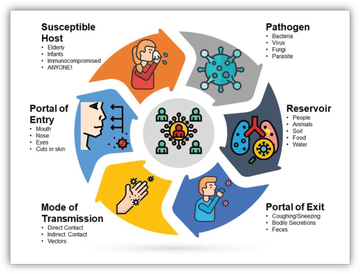Preventing Pathogens Transmission

To identify the preventive measures to break the chain of pathogens transmission.

45 minutes

Presentations, group work

Posters

Definitions to Note:
Routes:
Transmission:
Pathogens:
Microorganism:
Modes of Transmission: how the infectious agent is transmitted from one person to another. It can be in the form of droplets, direct or indirect contact, or through airborne transmission.
Chain of Infection: certain conditions must be met in order for a microbe or infectious disease to be spread from person to person. This process is known as the chain of infection (CDC, 2016) (more below).
Activity:
- Based on your learning from previous section, try to think what are the preventive measures of breaking the chain of infection.
- Once you have identified a few, read on to find if you were correct!

Guiding Information:
Chain of Infection:
- Certain conditions must be met in order for a microbe or infectious disease to be spread from person to person. This process is known as the Chain of Infection (CDC, 2016) which is shown in the figure below.

- There are 6 steps in the Chain of Infection and transmission will only take place if all 6 links are intact.
- Infectious Agent (Pathogen): microorganism (e.g. virus, bacteria or fungi)
- Reservoir (the source): a host which allows the microorganism to live, and possibly grow, and multiply. Humans, animals and the environment can all be reservoirs for microorganisms.
- Portal of Exit: a path for the microorganism to escape from the host. This can happen through the mouth (if a person coughs or sneezes), through a cut (if a person is bleeding), during diaper changes or using a toilet.
- Mode of Transmission: how the infectious agent is transmitted from one person to another. It can be in the form of droplets, direct or indirect contact, or through airborne transmission (see the 'Modes of Pathogen Transmission' section again).
- Portal of Entry: a place for the microorganism to get into a new host, similar to the Portal of Exit.
- Susceptible Host: it’s either a baby, an elderly person or someone with a weakened immune system that is susceptible to the infectious agent.
If any of the links above are broken then the infection will not occur. 'Infection Control' principles are aimed at breaking one or more links in this chain.
Breaking the Chain to Save a Life
- Infectious Agent (Pathogen): the cycle begins here, with a microorganism that is capable of producing infection. This may include viruses, bacteria, parasites and fungi microorganism.
- How to Break the Chain: early detection and diagnosis of the infectious agent is essential to prevent its spread.
- Reservoir (the source): infectious agents live and thrive in many environments, be it on your hands, desk or equipment.
- How to Break the Chain: reduce the Reservoir by practicing regular hand hygiene and keeping your environment clean.
- Portal of Exit: infectious agents can exit through the mouth, nose, eyes, stool, urine or open wounds, and without proper etiquette, can be easily transmitted.
- How to Break the Chain: respiratory etiquette such as covering your mouth with your elbow when sneezing or coughing, will help prevent the transmission, as will cleaning your hands after doing so.
- Mode of Transmission: the transmission of an infectious agent from one person to another can occur through direct contact, for example by shaking hands, or through indirect contact such as sharing the same phone etc.
- How to Break the Chain: proper cleaning and disinfection is crucial, along with the proper use of protective equipment.
- Portal of Entry: the infectious agent enters a new host in the same way it exited: through the mouth, nose, eyes, stool, urine or open wounds.
- How to Break the Chain: you must practice proper hand hygiene and other aseptic techniques to prevent further contamination and spread.
- Susceptible Host: the infection reaches a new host, any individual who is at risk of infection. Factors such as age, disease history and a compromised immune system can increase this risk.
- How to Break the Chain: at this stage in the cycle, treatment of the underlying infection is required. It is also recommended to educate the infected person on how to protect themselves and their loved ones from contracting infections.
- How to Break the Chain: at this stage in the cycle, treatment of the underlying infection is required. It is also recommended to educate the infected person on how to protect themselves and their loved ones from contracting infections.
Average Rating: ☆ ☆ ☆ ☆ ☆ (0 reviews)

